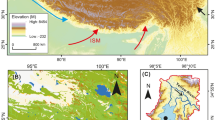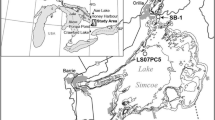Abstract
Multiple proxy indicators are regularly used to present robust arguments for paleoenvironmental change. We use fossil pollen and diatoms from a 495-cm core taken from Cootes Paradise, a coastal wetland in the western end of Lake Ontario, to investigate ecological changes in the late Holocene. We use consensus analysis to demonstrate that pollen diagrams are best zoned after the data have been split into source area, in this case upland and wetland taxa, because each group responds differently to environmental change. We also use consensus analysis to demonstrate the sensitivity of clustering to the distance measure used. The record begins at 2400 14C years BP, when the wetland was dominated by shallow water emergents and epiphytic diatoms. At 2100 14C years BP, a decline in the epiphytic diatoms Epithemia spp., a rise in Poaceae (cf. Zizania aquatica) pollen and a coincident increase in pollen concentration suggest a water level rise at this time. At about 800 14C years BP, the diatom record shows a pulse in small benthic Fragilaria species; shortly after, a shift occurs in the upland tree pollen spectra involving an increase in Pinus and a decline in Fagus. This shift in upland forest trees has been associated elsewhere with the Little Ice Age and the diatom data present some evidence for impacts of this climatic event on aquatic systems. The diatom and pollen records both indicate large changes associated with the effects of European settlement, including rises in Ambrosia as well as Typha angustifolia pollen. Planktonic diatoms dominate post-settlement assemblages indicating large-scale hydrological and ecological changes, probably associated with the introduction of carp and alterations to the Iroquois bar which separates the wetland from Lake Ontario. Our work at Cootes Paradise is important for multi-proxy coastal wetland studies in general, in addition to the late Holocene environmental history and prehistory of the Great Lakes region.
Similar content being viewed by others
References
T.W. Anderson C.F.M. Lewis (1985) Postglacial water-level history of the Lake Ontario Basin P.F. Karrow P.E. Calkin (Eds) Quaternary Evolution of the Great Lakes. Geological Association of Canada Special Paper 30 St. John’s, Nfld Canada 213–253
R.W. Battarbee V.J. Jones R.J. Flower N.G. Cameron H. Bennion L. Carvalho S. Juggins (2001) Diatoms J.P. Smol H.J.B. Birks W.M. Last (Eds) Tracking Environmental Change Using Lake Sediments, Vol. 3: Terrestrial, Algal, and Siliceous Indicators Kluwer Dordrecht 155–202
K.D. Bennett (1996) ArticleTitleDetermination of the number of zones in a biostratigraphical sequence New Phytol. 132 155–170
K.D. Bennett K.J. Willis (2001) Pollen J.P. Smol H.J.B. Birks W.M. Last (Eds) Tracking Environmental Change Using Lake Sediments, Vol. 3: Terrestrial, Algal, and Siliceous Indicators Kluwer Dordrecht 5–32
J.C. Berry R.J. Drimmie (1982) ArticleTitleUniversity of Waterloo radiocarbon dates I Radiocarbon 24 68–82
R.B. Brugam K. McKeever L. Kolesa (1998) ArticleTitleA diatom-inferred water depth reconstruction for an Upper PeninsulaMichigan, lake J. Paleolimnol. 20 267–276
I.D. Campbell J.H. McAndrews (1991) ArticleTitleCluster analysis of late Holocene pollen trends in Ontario Can. J. Bot. 69 1719–1730
P. Chow-Fraser B. Crosbie D. Bryant B. McCary (1996) ArticleTitlePotential contribution of nutrients and polycyclic aromatic hydrocarbons from the Creeks of Cootes Paradise Marsh Water Qual. Res. J. Can. 31 1618–1629
J.P. Coakley P.F. Karrow (1994) ArticleTitleReconstruction of post-Iroquois shoreline evolution in western Lake Ontario Can. J. Earth Sci. 31 1618–1629
L.C. Cwynar E. Burden J.H. McAndrews (1979) ArticleTitleInexpensive sieving method for concentrating pollen and spores from fine-grained sediments Can. J. Earth Sci. 16 1115–1120
Davis J.A. 2002. Measured and predicted compositional responses of a fish community to the restoration of a degraded urban coastal wetland. MSc Thesis, University of TorontoToronto146pp.
W.E. Dean SuffixJr. (1974) ArticleTitleDetermination of carbonate and organic matter in calcareous sediments and sedimentary rocks by loss-on-ignition: comparison with other methods J. Sed. Petrol. 44 242–248
M.J. Dear J.J. Drake L.G. Reeds (1987) Steel City: Hamilton and Region University of Toronto Press Toronto 308
W.G. Dore (1969) Wild Rice Agriculture Canada Publication 1393 Ottawa 84
M.S.V. Douglas J.P. Smol (1999) Freshwater diatoms as indicators of environmental change in the High Arctic E.F. Stoermer J.P. Smol (Eds) The Diatoms: Applications for the Environmental and Earth Sciences Cambridge University Press Cambridge 227–263
J.C. Earle H.C. Duthie (1984) A multivariate statistical approach for interpreting marshland diatom succession M. Ricard (Eds) 8th Diatom SymposiumParis Koeltz Scientific Books Koenigstein, Germany 441–458
S.A. Finkelstein (2003) ArticleTitleIdentifying pollen grains of Typha latifoliaTypha angustifoliaTypha x glauca Can. J. Bot. 81 985–990
J.E. Flint R.W. Dalrymple J.J. Flint (1988) ArticleTitleStratigraphy of the sixteen Mile Creek lagoon, and its implications for Lake Ontario water levels Can. J. Earth Sci. 25 1175–1183
S.M. Galatowitsch N.O. Anderson P.D. Ascher (1999) ArticleTitleInvasiveness in wetland plants in temperate North America Wetlands 19 733–755
E.C. Grimm (1987) ArticleTitleCONISS: a Fortran-77 program for stratigraphically constrained cluster analysis by the method of incremental sum of squares Comp. Geosci. 13 13–35
Grimm E.C. 1993. Tilia (Version 2.0.b.4) and Tilia-Graph (Version 2.0.b.5). Illinois State MuseumSpringfieldIL.
Juggins S. 1991. Zone 1.2. Available at http://www.campus.ncl.ac.uk/staff/Stephen.Juggins/software/zonehome.htmaccessed September 2003.
Karrow P. 1987. Quaternary Geology of the Hamilton-Cambridge Area, Southern Ontario. Report 255. Mines and Minerals Division, Ontario Geological Survey, 94 pp.
K. Krammer (1997) Die cymbelloiden Diatomeen: Eine Monographie der weltweit bekannten Taxa J. Cramer Berlin 469
K. Krammer H. Lange-Bertalot (1986–1991) Bacillariophyceae. Susswasser-flora von Mitteleuropa 2(1–4) Gustav Fischer Stuttgart 2484
F.-J. Lapointe P. Legendre (1990) ArticleTitleA statistical framework to test the consensus of two nested classifications Syst. Zool. 39 1–13
G.-A. Lee A.M. Davis D.G. Smith J.H. McAndrews (2004) ArticleTitleIdentifying fossil wild rice (Zizania) pollen from Cootes ParadiseOntario J. Archaeol. Sci. 31 411–421
P. Legendre L. Legendre (1998) Numerical Ecology Elsevier Amsterdam 853
J.H. McAndrews (1981) Late Quaternary climate of Ontario: temperature trends from the fossil record W.C. Mahaney (Eds) Quaternary Paleoclimate. GeoAbstracts Norwich UK 319–355
J.H. McAndrews M. Boyko-Diakonow (1989) Pollen analysis of varved sediment at Crawford LakeOntario: evidence of Indian and European farming R.J. Fulton (Eds) Quaternary Geology of Canada and Greenland Geological Survey of Canada Ottawa 528–530
J.H. McAndrews A.A. Berti G. Norris (1973) Key to the Quaternary Pollen and Spores of the Great Lakes Region Royal Ontario Museum TorontoOntario 61
F.M.G. McCarthy J.H. McAndrews (1988) ArticleTitleWater levels in Lake Ontario 4230–2000 years BP: evidence from Grenadier PondTorontoCanada J. Paleolimnol. 1 99–113
S.G. Newmaster A.G. Harris L.J. Kershaw (1997) Wetland Plants of Ontario Lone Pine Edmonton, Canada 240
D.S. Painter K.J. McCabe W.L. Simser (1989) Past and Present Limnological Conditions in Cootes Paradise Affecting Aquatic Vegetation, Royal Botanical Gardens Technical Bulletin No. 13 Hamilton OntarioCanada 85
R. Patrick C.W. Reimer (1966, 1975) The Diatoms of the United States Exclusive of Alaska and Hawaii1 and 2. Monograph No. 13 The Academy of Natural Sciences of Philadelphia Philadelphia 688/213
J.W. Pengelly K.J. Tinkler W.G. Parkins F.M.G. McCarthy (1997) ArticleTitle12,600 years of lake level changes, changing sills, ephemeral lakes and Niagara Gorge erosion in the Niagara Peninsula and eastern Lake Erie basin J. Paleolimnol. 17 377–402
E. Reavie J.P. Smol (1998) Freshwater Diatoms from the St Lawrence River J. Cramer Stuttgart 136
F.J. Rohlf (1982) ArticleTitleConsensus indices for comparing classifications Math. Biosci. 59 131–144
F.J. Rohlf (1997) NTSYS-pc: A Numerical Taxonomy and Multivariate Analysis SystemVersion 2.02 Exeter Software SetauketNY
I.R. Smith (2002) ArticleTitleDiatom-based Holocene paleoenvironmental records from continental sites on northeastern Ellesmere Islandhigh Arctic, Canada J. Paleolimnol. 27 9–28
D.G. Smith T. Ormerod A.M. Davis M. Peros (1997) Prehistoric native ecology at Cootes ParadiseRoyal Botanical Gardens, Hamilton, Ontario S. Carty R. Murzin D. Powell D. Ramsay (Eds) Leading Edge 997: The Edge and the Point Hamilton Ontario 277–281
J.M. St Jacques M.S.V. Douglas J.H. McAndrews (2000) ArticleTitleMid-Holocene hemlock decline and diatom communities in Van Nostrand LakeOntarioCanada J. Paleolimnol. 23 385–397
J. Stockmarr (1971) ArticleTitleTablets with spores used in absolute pollen analysis Pollen Spores 13 615–621
E.F. Stoermer (1993) ArticleTitleEvaluating diatom succession: some peculiarities of the Great Lakes case J. Paleolimnol. 8 71–83
J. Terasmae J.J. Fortescue J.J. Flint E.F. Gawron R.F. Winn C.E. Winn (1972) Palynology and Chemistry of Lake Sediment Cores from Southern OntarioRelated to Man’s Activities on the EnvironmentBrock University Research Report Series No. 10 St Catharines Ontario 280
J.R. Yang H.C. Duthie (1994) Diatom paleoecology of East LakeOntario: a 5400 year record of limnological change D. Marino M. Montresor (Eds) Proceedings of the 13th International Diatom Symposium Biopress Limited Bristol, UK 555–571
Z. Yu J.H. McAndrews U. Eicher (1997) ArticleTitleMiddle Holocene dry climate caused by change in atmospheric circulation patterns: evidence from lake levels and stable isotopes Geology 25 251–254
Author information
Authors and Affiliations
Corresponding author
Rights and permissions
About this article
Cite this article
Finkelstein, S.A., Peros, M.C. & Davis, A.M. Late Holocene paleoenvironmental change in a Great Lakes coastal wetland: integrating pollen and diatom datasets. J Paleolimnol 33, 1–12 (2005). https://doi.org/10.1007/s10933-004-0423-3
Received:
Accepted:
Issue Date:
DOI: https://doi.org/10.1007/s10933-004-0423-3




